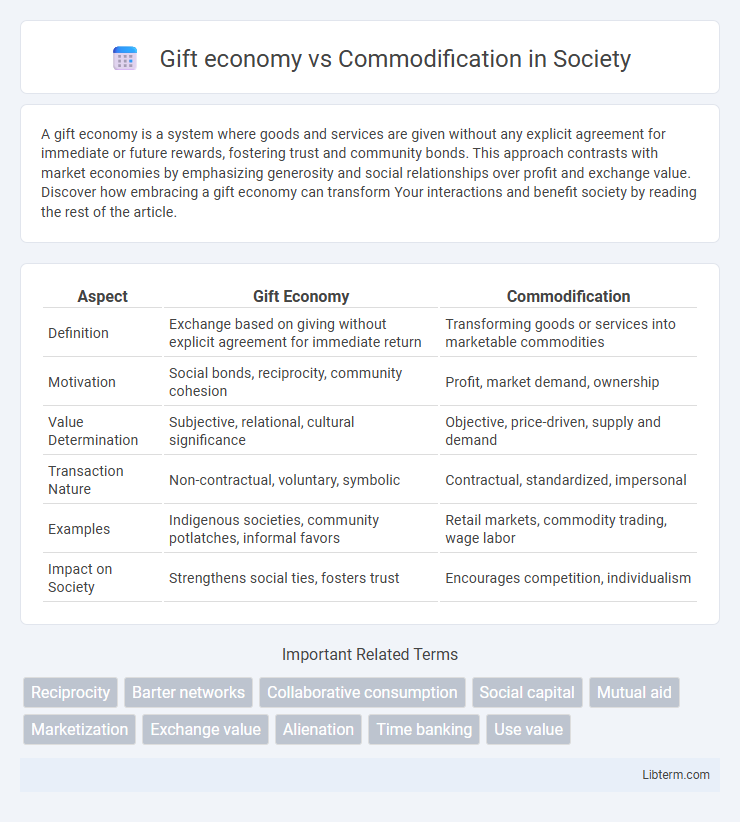A gift economy is a system where goods and services are given without any explicit agreement for immediate or future rewards, fostering trust and community bonds. This approach contrasts with market economies by emphasizing generosity and social relationships over profit and exchange value. Discover how embracing a gift economy can transform Your interactions and benefit society by reading the rest of the article.
Table of Comparison
| Aspect | Gift Economy | Commodification |
|---|---|---|
| Definition | Exchange based on giving without explicit agreement for immediate return | Transforming goods or services into marketable commodities |
| Motivation | Social bonds, reciprocity, community cohesion | Profit, market demand, ownership |
| Value Determination | Subjective, relational, cultural significance | Objective, price-driven, supply and demand |
| Transaction Nature | Non-contractual, voluntary, symbolic | Contractual, standardized, impersonal |
| Examples | Indigenous societies, community potlatches, informal favors | Retail markets, commodity trading, wage labor |
| Impact on Society | Strengthens social ties, fosters trust | Encourages competition, individualism |
Introduction to Gift Economy and Commodification
The gift economy operates on principles of reciprocity and social bonds, where goods and services are exchanged without explicit agreements or monetary transactions. Commodification transforms these goods, services, or social relations into marketable items with assigned monetary value, emphasizing profit over communal relationships. Understanding these concepts highlights the contrast between value based on social obligation and value derived from economic exchange.
Defining the Gift Economy: Core Principles
The gift economy is defined by voluntary exchanges where goods and services are given without explicit agreements for immediate or future rewards, emphasizing social bonds and community trust. Core principles include reciprocity, where gifts create relationships rather than transactions, and the circulation of wealth through generosity, contrasting sharply with commodification's focus on market value and profit. This system prioritizes communal well-being and shared resources over individual ownership and monetary exchange.
Commodification Explained: Key Concepts
Commodification involves transforming goods, services, ideas, or people into commodities with assigned market value for exchange purposes. This process emphasizes monetary transactions, standardization, and profit maximization, which contrasts with the non-monetary, reciprocal nature of a gift economy. Key concepts in commodification include objectification, alienation, and the reduction of social relations to market dynamics, influencing consumer behavior and societal structures.
Historical Context: Evolution of Exchange Systems
Gift economies dominated early human societies where social bonds and reciprocity governed resource distribution, reflecting communal values rather than individual profit. Over time, commodification emerged with the rise of agriculture and urbanization, shifting exchange systems toward market-based transactions and monetary value. This evolution highlights a fundamental transformation from relational reciprocity to detached commercial exchange within historical economic development.
Social Relationships in Gift Economies vs. Markets
Gift economies foster social relationships by emphasizing reciprocity, trust, and communal bonds, where exchanges contribute to social cohesion rather than individual profit. Commodification, characteristic of market economies, transforms social interactions into transactional exchanges driven by monetary value, often weakening social ties. In gift economies, value is embedded in relationships and social obligations, contrasting with markets where value is primarily measured by price and efficiency.
Value Creation: Intrinsic vs. Extrinsic Motivations
Gift economies foster value creation through intrinsic motivations such as social bonding, reciprocity, and community trust, emphasizing relationships over transactions. Commodification relies on extrinsic motivations driven by market exchange, monetary gain, and quantifiable metrics, prioritizing individual profit and economic efficiency. The intrinsic value in gift economies enhances cultural and social capital, whereas commodification converts goods and services into marketable assets evaluated mainly by exchange value.
Impact on Communities and Social Cohesion
Gift economies enhance social cohesion by fostering trust, reciprocity, and strong community bonds through non-monetary exchanges, strengthening collective identity and mutual support. Commodification transforms relationships into market transactions, potentially eroding communal values and undermining social ties by prioritizing individual gain over collective welfare. The contrasting impact of these systems shapes whether communities thrive on collaboration or become fragmented by economic competition.
Economic Efficiency: Strengths and Limitations
Gift economies foster social cohesion and trust by emphasizing reciprocal relationships, which can reduce transaction costs and enhance cooperative behavior. However, they may lack scalability and efficiency in resource allocation compared to commodification, where market-driven pricing mechanisms optimize supply and demand. Commodification promotes economic efficiency through price signals and competition but can lead to social inequalities and reduced community bonds.
Modern Examples of Gift Economies and Commodification
Modern examples of gift economies include open-source software communities like Linux and cryptocurrency projects such as Bitcoin, where contributions are shared freely without direct monetary exchange. Commodification is evident in platforms like Airbnb and Uber, which transform personal assets and services into market commodities for profit. The contrast highlights how digital and peer-to-peer networks foster collaborative value creation versus the monetization of previously non-market interactions.
Future Trends: Balancing Gifts and Commerce
Future trends in balancing gift economy and commodification emphasize hybrid models integrating digital platforms that facilitate both altruistic exchanges and commercial transactions, reflecting evolving consumer preferences for meaningful interactions alongside convenience. Blockchain technology and decentralized finance empower transparent, trust-based gifting systems while supporting commodified assets, driving innovation in peer-to-peer value exchange. Emerging social enterprise models leverage this balance to promote sustainability and community resilience, merging economic incentives with social impact.
Gift economy Infographic

 libterm.com
libterm.com